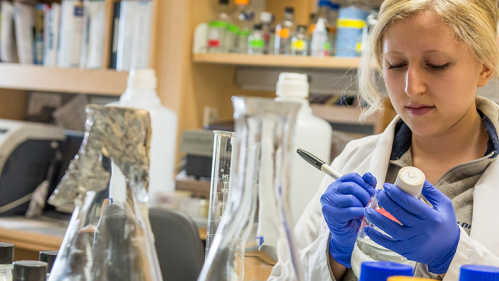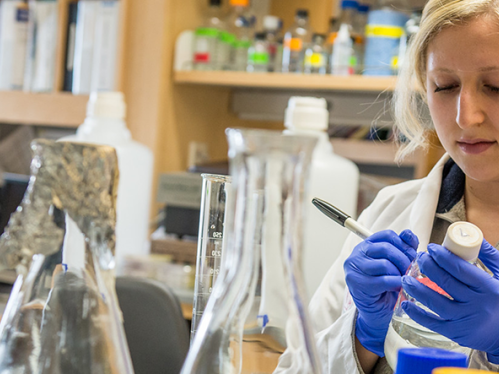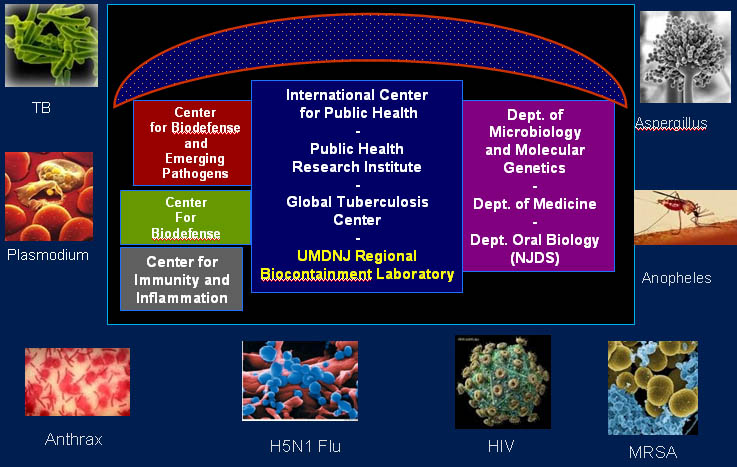
Animal Model Program
Small Animal Research Core
The goal of the Northeast Biodefense Regional Center of Excellence (NBC RCE) Small Animal Core, managed and operated by personnel at the Public Health Research Institute (PHRI) in the International Center for Public Health (ICPH) Research Animal Facility (RAF) at Rutgers-New Jersey Medical School, is to support the research objectives of NBC RCE scientists engaged in infectious disease studies that examine aspects of disease pathogenesis, pathogen-induced host immune responses, novel therapeutic strategies and adjunct treatment regimens, improved diagnostics and vaccine development in small animal model systems. The RBL is also partnering with academia and industry to study select agents and NIAID priority A-C pathogens. Contractual work can also be provided to institutions or companies that request our services.
Specialty
The Core specializes in the study of bacterial diseases caused by select agent pathogens including plague, tularemia, anthrax and glanders, as well as conventional, multidrug and extreme resistant forms of tuberculosis in mouse, hamster and rabbit model systems. We are currently using a Vaccinia virus infection in mice to assess novel vaccine candidates for the treatment of Small Pox. We are also developing model systems to examine other viral infections including SARS and Chikungunya virus in rodents or highly pathogenic avian influenza A H5N1 and other low pathogenic influenza strains in mice, ferrets and birds.

Equipment
The RBL has both whole body and nose only aerosol exposure systems for rodents and rabbits. The mouse exposure systems were designed by CH Technologies (Westwood, NJ) and Intox Products (Edgewood, NM). Additional equipment at the RBL includes a multi-modal in vivo imaging system for mice and rats from Perkin Elmer. Other techniques available in our facilities are flowcytometry, HPLC and mass spectometry.

Rutgers IACUC Approvals
The Rutgers Institutional Animal Care and Use Committee (IACUC) has approved 135 Animal Care and Use Protocols (ACUPs) and has approved 145 amendments since July 2004 to authorize infectious disease studies in the ICPH RAF. This includes 66 BSL3-level protocols, of which 35 (53%) cover select agent studies. A team of five BSL3 animal model specialists conduct research for approved protocols for 16 different research programs representing 14 different NBC-supported laboratories.
BSL3
The BSL3 has housing and lab procedure space for rodent and small animal studies. The BSL3 consists of 9 rodent housing rooms, 6 other small animals housing rooms, 6 tissue culture labs, 9 procedure rooms and 6 dedicated rooms for aerosol challenge. Each BSL3 rodent housing room is equipped with BioZone Inc. micro-isolator rack and caging systems that can accommodate either 6000 mice, 3000 rats/hamsters or 600 guinea pigs. Allentown Inc. individually ventilated caging systems (IVC) are used for rabbits, birds and ferrets studies. Four animal holding rooms (220 GSF each), four procedure rooms (220 GSF each) and two aerosol rooms (250 GSF) are dedicated to studies with select agents.
Major Accomplishments
- Supported studies for 16 PIs from 11 different NBC institutions;
- Logged a total of over 1,000,000 BSL3 animal days since 2004;
- Logged a total of 500,000 select agent animal days (50% of total BSL3);
- Select agent usage up over 400% since 2004 & remains steady;
- Developed aerosol models for bacterial infections and are developing intranasal influenza studies in mice and ferrets;
- Executed multi-institutional, cross-platform plague vaccine study;
- Trained 8 animal model specialists and 8 post doctoral researchers;
- Developed nucleic acid-based assays for determination of microbial burdens
- Molecular analysis including Flowcytometry, HPLC and Mass Spec in the BSL3
- Multi-modal in vivo imaging in the BSL3

Current Animal Projects
-
Skin and Soft Tissue Infection (SSTI) models for E.S.K.A.P.E. pathogens: Open wound infection model
Thigh infection (deep soft tissue) model
Pneumonia model for E.S.K.A.P.E. pathogens
Murine intranasal infection model for bacterial select agents
Murine intranasal infection model for viral select agents -
Bacteremia model
Viremia model
Acute murine model of inhalational TB to evaluate treatment efficacy
Chronic murine model of inhalational TB to evaluate treatment efficacy
Influenza transmission (guinea pigs) -
Digital wound measurements and closure
In vivo imaging of bacterial pathogens in SSTI models
Expression profiling of host wound healing genes
Histopathological analysis
Reduction of microbial burden in wound sites or target organs
Pharmacokynetics and pharmodynamics of antiviral peptides
The RBL greatly expands the research capability in infectious diseases in-place at New Jersey Medical School
